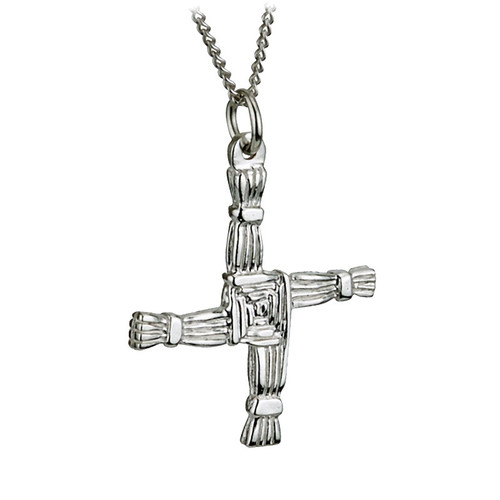This sterling silver St Brigid's cross pendant has been created by our expert designers in Connemara marble, a unique stone that dates back over 900 million years and is known as “Ireland’s gemstone”. Our Connemara marble is authentic, coming from the Joyce family mine in Connemara itself. The St. Brigid's Cross on this pendant is a powerful symbol of faith, dating back to the ninth century. This marble St. Brigid's pendant has been Irish hallmarked in Dublin Castle.
18" Sterling Silver Trace Chain. Approx. Width 22mm, Height 25mm. Presentation box included.
In Christian religion, St. Brigid and her cross are linked together by a story about her weaving this form of cross at the death bed of either her father or a pagan lord, who upon hearing what the cross meant, asked to be baptized. One version goes as follows:
A pagan chieftain from the neighbourhood of Kildare was dying. Christians in his household sent for Brigid to talk to him about Christ. When she arrived, the chieftain was raving. As it was impossible to instruct this delirious man, hopes for his conversion seemed doubtful. Brigid sat down at his bedside and began consoling him. As was customary, the dirt floor was strewn with rushes both for warmth and cleanliness. Brigid stooped down and started to weave them into a cross, fastening the points together. The sick man asked what she was doing. She began to explain the cross, and as she talked, his delirium quieted and he questioned her with growing interest. Through her weaving, he converted and was baptized at the point of death. Since then, the cross of rushes has existed in Ireland.
The presence of the cross in Ireland is, however, likely far older. The Goddess Brigid was one of the Tuatha De Danann. Her feast day was the feast of Imbolc, and the cross made of rushes today is very likely the descendant of a pagan symbol whose original meaning may have been locally understood even into the early 20th century in rural Ireland. One remnant of that tradition in the meaning of the Brigid's Cross today, is that it is said to protect a house from fire. This does not fit with any part of the Christian story of St. Brigid, and so is likely a part of the older polytheistic tradition behind the feast day.








